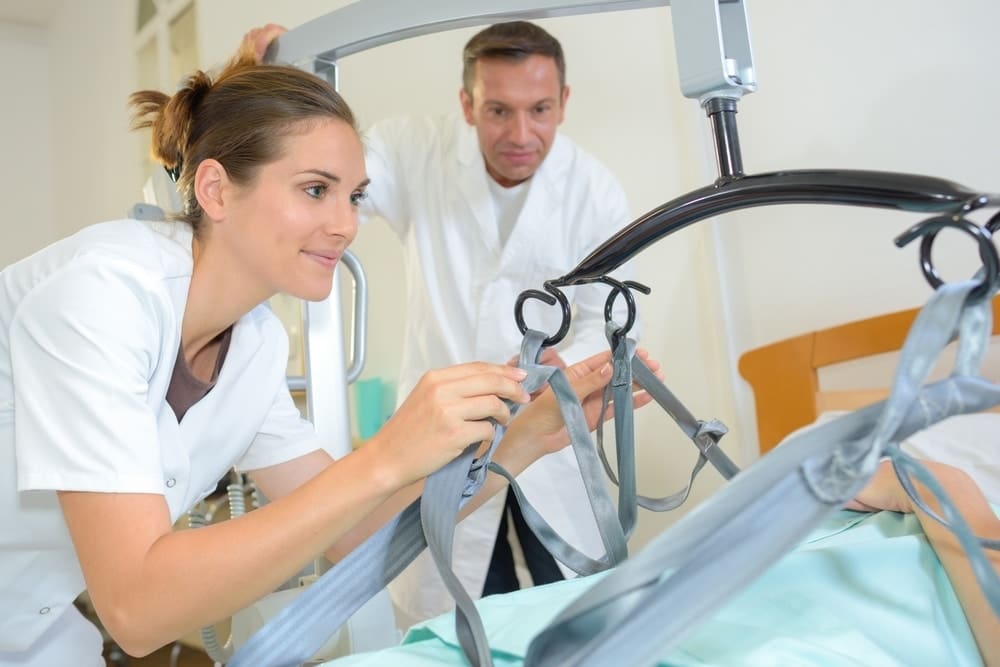
Maintaining safety at home becomes a priority for many individuals as they age or face mobility limitations. Patient floor lifts can be a game-changer in these situations, offering a safe and dignified way to transfer from beds, chairs, toilets, and wheelchairs.
Patient lifts offer significant benefits to the user and caregiver. When an individual is no longer able to move independently, patient lifts are designed to safely transfer them with a significantly reduced risk of falling when compared to being carried. They also protect caregivers from back strain and fatigue associated with lifting, carrying, and moving patients.
A patient lift is designed to help move patients from one place to another, such as from a bed to a bath or from a chair to the floor. Although designs can vary by manufacturer, the basic components typically include a mast (the vertical bar that fits into the base), a boom (a bar that extends over the patient), a spreader bar (which hangs from the boom), a sling (attached to the spreader bar to hold the patient), and several clips or latches to secure the sling.

The legs on the base are mounted on wheels and have the ability to spread out wider and move back together. When expanded, it creates a wider base of support and allows the legs of the lift to go around the base of a chair positioning the user directly above the chair.
There are a variety of slings to choose from depending on the level of support needed and model of lift you choose. If your need includes transfers for toileting and self-care, there are slings especially designed with convenience and safety in mind. Full body slings can have 4,6, or 8 sling points (straps) that hook to the spreader bar. Most lift models have one spreader bar with 4 hooks to connect the sling. The design can vary across brands but the overall method is the same.

Patient floor lifts come in a variety of configurations to suit various requirements. Let’s explore the main categories:
Manual lifts offer the benefit of being lighter, less expensive, and have a smaller footprint than an electric lift, but there are a couple of downsides. For caregivers dealing with neck or back pain, or just feeling a bit weak, operating them can be strenuous. Additionally, since it works with levers, the motion stops and starts with each pull, which can be unsettling, especially if they’re already feeling agitated or easily startled.
The lift is plugged into a standard outlet to charge when not in use. Some models come with a removable battery for a more convenient method of recharging. For increased safety, power lifts will not operate while plugged in.
Besides being easier for the caregiver to use, power lifts provide a smoother ride for the patient. The trade off is a higher price tag, larger, heavier frame that takes up more space and can be harder to maneuver.
Both manual and power models work with a sling that wraps around the patient’s back and hooks onto two loops in the front of the lift. With their feet resting on a footplate and a padded knee guard for support, patients can prevent sliding forward during the lift. These lifts are ideal for users who:
 Car Transfer Floor Lift: These lifts are designed with a unique spreader bar and sling that allows for easier transfers in and out of the car. The base is intentionally designed to fold so it can be easily transported and used when you reach your destination.
Car Transfer Floor Lift: These lifts are designed with a unique spreader bar and sling that allows for easier transfers in and out of the car. The base is intentionally designed to fold so it can be easily transported and used when you reach your destination.Choosing the right patient lift requires careful consideration. Consult first with your doctor, and/or physical therapist and learn what model of lift and sling would be best based on your lifestyle and needs. Then seek the help and knowledge of a reputable medical equipment supply store like All-Star Medical. The knowledge and experience we’ve gained over years of working with customers and equipment can be an invaluable resource. Based on your medical professionals recommendation, we work with you to find the most appropriate lift and sling combination to meet your needs.
The showrooms at each of our locations boast a large selection of various medical products including lift chairs, mobility scooters, power wheelchairs and even stair lifts. These models provide you with the opportunity for hands-on experience before you purchase. With our knowledgeable staff ready to answer your questions, you can ensure you choose the perfect solution for safety and comfort.
3520A Central Pike
Hermitage, TN 37076
615-730-9438
332 Southgate Ct
Brentwood TN 37027
615-567-6116
Monday-Friday: 9am-5pm
Saturday & Sunday: Closed
3520A Central Pike
Hermitage, TN 37076
615-730-9438
332 Southgate Ct
Brentwood TN 37027
615-567-6116
Monday-Friday: 9am-5pm
Saturday & Sunday: Closed

[copy content=”PIN6″]Click here to copy to clipboard[/copy]
Notifications